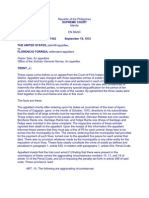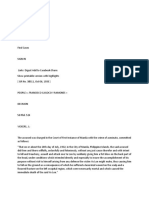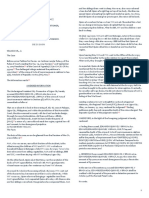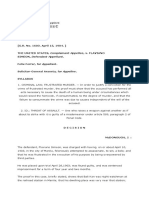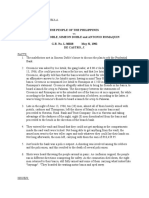People Vs Jose
People Vs Jose
Uploaded by
Laarni LacsinaCopyright:
Available Formats
People Vs Jose
People Vs Jose
Uploaded by
Laarni LacsinaOriginal Title
Copyright
Available Formats
Share this document
Did you find this document useful?
Is this content inappropriate?
Copyright:
Available Formats
People Vs Jose
People Vs Jose
Uploaded by
Laarni LacsinaCopyright:
Available Formats
PEOPLE VS PO3 FALLORINA FACTS:For automatic review is the Decision of the Regional Trial Court of Quezon City, Branch
95, convicting appellant PO3 Ferdinand Fallorina y Fernando of murder for the killing of eleven-year-old Vincent Jorojoro, Jr. while the latter was flying his kite on top of a roof. The court a quo sentenced the appellant to suffer the death penalty. The accusatory portion of the Information charging the appellant with murder reads: That on or about the 26th day of September 1998, in Quezon City, Philippines, the said accused, with intent to kill, by means of treachery and taking advantage of superior strength, did then and there, wilfully, unlawfully and feloniously attack, assault and employ personal violence upon the person of VINCENT JOROJORO, JR. y MORADAS, a minor, eleven (11) years of age, by then and there, shooting him with a gun, hitting him on the head, thereby inflicting upon him serious and mortal wound which was the direct and immediate cause of his death, to the damage and prejudice of the heirs of the said offended party. ISSUE: Whether or not the appellant is exempt from criminal liability? HELD:The appellant was burdened to prove, with clear and convincing evidence, his affirmative defense that the victim's death was caused by his gun accidentally going off, the bullet hitting the victim without his fault or intention of causing it; hence, is exempt from criminal liability under Article 12, paragraph 4 of the Revised Penal Code which reads The following are exempt from criminal liability 4. Any person who, while performing a lawful act with due care, causes an injury by mere accident without fault or intention of causing it. The basis for the exemption is the complete absence of intent and negligence on the part of the accused. For the accused to be guilty of a 33 felony, it must be committed either with criminal intent or with fault or negligence. The elements of this exempting circumstance are (1) a person is performing a lawful act; (2) with due care; (3) he causes an injury to another by 34 mere accident; and (4) without any fault or intention of causing it. An accident is an occurrence that "happens outside the sway of our will, and although it comes about through some act of our will, lies beyond the bounds of humanly foreseeable consequences." If the consequences are plainly foreseeable, it will be a case of negligence. IN LIGHT OF ALL THE FOREGOING, the Decision of the Regional Trial Court of Quezon City, Branch 95, is AFFIRMED WITH MODIFICATION. The appellant PO3 Ferdinand Fallorina y Fernando is found guilty beyond reasonable doubt of the crime of murder under Article 248 of the Revised Penal Code and, there being no modifying circumstances in the commission of the crime, is hereby sentenced to suffer the penalty of reclusion perpetua. He is also ordered to pay the heirs of the victim Vincent Jorojoro, Jr. the amount of P49,174 as actual damages; P50,000 as moral damages; P50,000 as civil indemnity; and P25,000 as exemplary damages. People vs. Jose L-28232 February 6, 1991 Nature: Appeal from and automatic review of a decision of Rizal CFI June 26, 1967 Magdalena de la Riva was abducted outside her own by Jaime Jose, Edgardo Aquino, Basilio Pineda and Rogelio Canal. They brought Maggie to Swanky Hotel. Jose, Aquino, Pineda and Canal took turns raping Maggie. They decided to leave her on a spot in front of the Free Press Building not far from Epifanio de los Santos Avenue near Channel 5 to make it appear, according to them, that the complainant had just come from the studio. They threatened that she would be doused with acid if she would inform anyone of the incident. When she was inside the cab and alone with the driver, Miguel F. Campos, she broke down and cried. She kept asking the driver if a car was following them; and each time the driver answered her in the negative When she reached home she informed her mother of the incident Appellant Canal and Pineda executed swore to separate statements on the day of their arrest Caal confirmed the information previously given by Jose that the four of them waited for Miss De la Riva to come down from the ABS Studio, and that they had planned to abduct and rape her. Appellant Caal admitted that all four of them participated in the commission of the crime, but he would make it appear that insofar as he was concerned the complainant yielded her body to him on condition that he would release her Pineda executed a statement stating that he and his other three companions wept to the ABS Studio, and that, on learning that Miss De la Riva was there, they made plans to wait for her and to follow her. He admitted that his group followed her car and snatched her and took her to the Swanky Hotel. He would make it appear, however, that the complainant voluntarily acceded to having sexual intercourse with him.
1
Jose, Aquino, Canal pleaded not guilty while Pineda pleaded guilty. Issues 1. WON the accused were motivated by lewd designs. YES
YES. Jose, Aquino and Caal deny having had anything to do with the abduction of Miss De la Riva. They point to Pineda (who entered a plea of guilty) as the sole author thereof, but they generously contend that even as to him the act was purged at any taint of criminality by the complainants subsequent consent to perform a striptease show for a fee, a circumstance which, it is claimed, negated the existence of the element of lewd design. This testimony of Ms. De la Riva, whose evidentiary weight has not in the least been overthrown by the defense, more than suffices to establish the crimes charged in the amended complaint. The claims of the accused that they were not motivated by lewd designs must be rejected as absolutely without factual basis. 2. WON the accused rape Ms. de la Riva.
YES. Jose, Aquino and Canal contend that the absence of semen in the complainants vagina disproves the fact of rape. Dr. Brion stated that semen is not usually found in the vagina after three days from the last intercourse, especially if the subject has douched herself within that period The absence of spermatozoa does not disprove the consummation of rape, the important consideration being, not the emission of semen, but penetration. When the victim got home she immediately told her mother that the four raped her. The statement was made by the complainant to her mother who, in cases of this nature was the most logical person in whom a daughter would confide the truth. 3. WON the extrajudicial statements is admissible.
YES. The accused contends that secured from them by force and intimidation, and that the incriminating details therein were supplied by the police investigators. The statements were given in the presence of several people & subscribed & sworn to before the City Fiscal of QC, to whom neither of the aforesaid appellants intimated the use of inordinate methods by the police. They are replete w/ details which could hardly be known to the police; & although it is suggested that the authorities could have secured such details from their various informers, no evidence at all was presented to establish the truth of such allegation. Even disregarding the in-custody statements of Jose and Canal, We find that the mass of evidence for the prosecution on record will suffice to secure the conviction of the two. 4. WON there was a mistrial for Pineda.
NO. Pineda contends that there was a mistrial resulting in gross miscarriage of justice. He contends that because the charge against him and his co-appellants is a capital offense & the amended complaint cited aggravating circumstances, which, if proved, would raise the penalty to death, it was the duty of the court to insist on his presence during all stages of the trial. The court held that plea of guilty is mitigating, at the same time it constitutes an admission of all the material facts alleged in the information, including the aggravating circumstances, and it matters not that the offense is capital, for the admission (plea of guilty) covers both the crime and its attendant circumstances qualifying and/or aggravating the crime it was not incumbent upon the trial court to receive his evidence, much less to require his presence in court. It would be different had appellant Pineda requested the court to allow him to prove mitigating circumstances, for then it would be the better part of discretion on the part of the trial court to grant his request. 5. WON the enormous publicity of the case affected the decision of the trial court.
NO. The appellants took notice of the enormous publicity that attended the case from the start of investigation to the trial. Jose himself admits in his brief that the Trial Judge had not been influenced by adverse and unfair comments of the press, unmindful of the rights of the accused to a presumption of innocence and to fair trial. 6. WON aggravating circumstances were present.
YES. Nighttime, appellants having purposely sought such circumstance to facilitate the commission of these crimes
Abuse of superior strength, the crime having been committed by the four appellants in conspiracy with one another (Cf. People vs. De Guzman, et al., 51 Phil., 105, 113) Ignominy, since the appellants in ordering the complainant to exhibit to them her complete nakedness for about ten minutes, before raping her, brought about a circumstance which tended to make the effects of the crime more humiliating. use of a motor vehicle. 7. WON the imposition of four death penalty is valid.
YES. The Supreme Court held that in view of the existence of conspiracy among the accused and of its finding regards the nature and number of crimes committed, as well as the presence of aggravating circumstances, four death penalties can be imposed. People vs. Regala GR No. 130508 April 5, 2000 Robbery with rape That on or about September 11, 1995, in the evening thereof, at Barangay Bangon, Municipality of Aroroy, Province of Masbate, Philippines, within the jurisdiction of this Court, the said accused confederating together and helping one another, with intent to gain, violence and intimidation upon persons, did then and there wilfully, unlawfully and feloniously enter the kitchen of the house of Consuelo Arevalo and when inside, hogtied said Consuelo Arevalo and granddaughter Nerissa Regala (sic), take, steal, rob and carry away cash amount of P3,000.00 and two (2) gold rings worth P6,000.00, to the damage and prejudice of owner Consuelo Arevalo in the total amount of P9,000.00, Philippine Currency; and in pursuance of the commission of the crime of robbery against the will and consent of the granddaughter Nerissa Regala (sic) wilfully, unlawfully and feloniously accused Armando Regala y Abriol has for two times sexually abused and/or intercoursed with her, while hogtied on the bed and in the kitchen. Accused-appellant was charged and convicted of robbery with rape. Held: It should be noted that there is no law providing that the additional rape/s or homicide/s should be considered as aggravating circumstance. The enumeration of aggravating circumstances under Article 14 of the Revised Penal Code is exclusive as opposed to the enumeration in Article 13 of the same code regarding mitigating circumstances where there is a specific paragraph (paragraph 10) providing for analogous circumstances. It is true that the additional rapes (or killings in the case of multiple homicide on the occasion of the robbery) would result in an anomalous situation where from the standpoint of the gravity of the offense, robbery with one rape would be on the same level as robbery with multiple rapes. However, the remedy lies with the legislature. A penal law is liberally construed in favor of the offender and no person should be brought within its terms if he is not clearly made so by the statute. In view of the foregoing, the additional rape committed by herein accused-appellant should not be considered as aggravating. The penalty of reclusion perpetua imposed by the trial court is proper. case digests, case digests of supreme court decisions, case digests Philippines, mobile phone deals, laptop computers, gadgets, free legal opinion, online jobs, best law firms in Mindanao People vs. Narvaez G.R. No. 33466 April 20, 1983 Nature: Appeal from decision of the CFI of South Cotabato Facts: Mamerto Narvaez has been convicted of murder (qualified by treachery) of David Fleischer and Flaviano Rubia. On August 22, 1968, Narvaez shot Fleischer and Rubia during the time the two were constructing a fence that would prevent Narvaez from getting into his house and rice mill. The defendant was taking a nap when he heard sounds of construction and found fence being made. He addressed the group and asked them to stop destroying his house and asking if they could talk things over. Fleischer responded with No, gadamit, proceed, go ahead. Defendant lost his equilibrium, and shot Fleisher with his shotgun. He also shot Rubia who was running towards the jeep where the deceaseds gun was placed. Prior to the shooting, Fleischer and Co. (the company of Fleischers family) was involved in a legal battle with the defendant and other land settlers of Cotabato over certain pieces of property. At the time of the shooting, the civil case was still pending for annulment (settlers wanted granting of property to Fleisher and Co. to be annulled). At time of the shooting, defendant had leased his property from Fleisher (though case pending and ownership uncertain) to avoid trouble. On June 25, defendant received letter terminating contract because he allegedly didnt pay rent. He was given 6 months to remove his house from the land. Shooting was barely 2 months after letter. Defendant claims he killed in defense of his person and property. CFI ruled that Narvaez was guilty. Aggravating circumstances of evident premeditation offset by the mitigating circumstance of voluntary surrender. For both murders, CFI sentenced him to reclusion perpetua, to indemnify the heirs, and to pay for moral damages. Issues: 1. WON CFI erred in convicting defendant-appellant despite the fact that he acted in defense of his person.
No. The courts concurred that the fencing and chiselling of the walls of the house of the defendant was indeed a form of aggression on the part of the victim. However, this aggression was not done on the person of the victim but rather on his rights to property. On the first issue, the courts did not err. However, in consideration of the violation of property rights, the courts referred to Art. 30 of the civil code recognizing the right of owners to close and fence their land. Although is not in dispute, the victim was not in the position to subscribe to the article because his ownership of the land being awarded by the government was still pending, therefore putting ownership into question. Its accepted that victim was the original aggressor. 2. WON the court erred in convicting defendant-appellant although he acted in defence of his rights.
Yes. However, the argument of the justifying circumstance of self-defense is applicable only if the 3 requirements are fulfilled. Art. 11(1) RPC enumerates these requisites: Unlawful aggression. In the case at bar, there was unlawful aggression towards appellants property rights. Fleisher had given Narvaez 6 months and he should have left him in peace before time was up, instead of chiseling Narvaezs house and putting up fence. A536 of the CC also provides that possession may not be acquired through force or intimidation; while Art. 539 provides that every possessor has the right to be respected in his possession Reasonable necessity of means employed to prevent or repel attack. In case, killing was disproportionate to attack. Lack of sufficient provocation on part of person defending himself. Here, there was no provocation at all since he was asleep Since not all requisites present, defendant is credited w/ the special mitigating circumstance of incomplete defense, pursuant to A13(6) RPC. These mitigating circumstances are: voluntary surrender & passion & obfuscation (read p. 405 explanation) Crime is homicide (2 counts) not murder because treachery is not applicable on account of provocation by the deceased. Also, assault wasnt deliberately chosen with view to kill since slayer acted instantaneously. There was also no direct evidence of planning or preparation to kill. Art. 249 RPC: Penalty for homicide is reclusion temporal. However, due to mitigating circumstances and incomplete defense, it can be lowered 3 degrees (Art. 64) to arresto mayor. 3. WON he should be liable for subsidiary imprisonment since he is unable to pay the civil indemnity due to the offended party.
No. He isnt liable to be subsidiarily imprisoned for non-payment of civil indemnity. RA 5465 made the provisions of A39 applicable to fines only & not to reparation of damage caused, indemnification of consequential damages & costs of proceedings. Although it was enacted only after its commission, considering that RA 5465 is favorable to the accused who is not a habitual delinquent, it may be given retroactive effect pursuant to RPC A22. Judgment: Defendant guilty of homicide but w/ mitigating circumstances and extenuating circumstance of incomplete self defense. Penalty is 4 mos. arresto mayor & to indemnify each group of heirs 4K w/o subsidiary imprisonment & w/o award for moral damages. Appellant has already been detained 14 yrs so his immediate release is ordered. Gutierrez, dissenting. Defense of property can only be invoked when coupled with form of attack on person defending property. In the case at bar, this was not so. Appellant should then be sentenced to prision mayor. However, since he has served more than that, he should be released.
You might also like
- Outline For Legal ResearchDocument3 pagesOutline For Legal ResearchTurbonisNo ratings yet
- Anthony Pagden The Idea of Europe (2002)Document393 pagesAnthony Pagden The Idea of Europe (2002)Branc Georgiana100% (3)
- Gender Sensitivity, Human Rights, Laws On Women and Children's RightsDocument5 pagesGender Sensitivity, Human Rights, Laws On Women and Children's Rightskh7swwkgbvNo ratings yet
- Bridge of SpiesDocument3 pagesBridge of Spiesjenny carolina llanos murilloNo ratings yet
- Suryanelli Case HC JudgementDocument140 pagesSuryanelli Case HC JudgementRama Nathan100% (1)
- Javellana Vs Executive SecretaryDocument4 pagesJavellana Vs Executive SecretaryErrol OstanNo ratings yet
- People V Beronilla: Obedience To Lawful Order of A SuperiorDocument2 pagesPeople V Beronilla: Obedience To Lawful Order of A SuperiorgiogmailNo ratings yet
- Complaint For Securities Fraud OregonDocument12 pagesComplaint For Securities Fraud OregonKatia Alcantar0% (1)
- Local Budget ProcessDocument58 pagesLocal Budget ProcessAricirtap Abenoja JoyceNo ratings yet
- Crim. Law I Syllabus v.2Document15 pagesCrim. Law I Syllabus v.2Patrick ManaloNo ratings yet
- People Vs Leuterio DIGESTDocument2 pagesPeople Vs Leuterio DIGESTJohn Fredrick BucuNo ratings yet
- People Vs SuganDocument3 pagesPeople Vs SuganAprilleMaeKayeValentinNo ratings yet
- CRIM1 Padilla v. DizonDocument7 pagesCRIM1 Padilla v. DizonChedeng KumaNo ratings yet
- Aggravating CasesDocument114 pagesAggravating CasesRonn PetittNo ratings yet
- People Vs Bonoan 64 Phil 87Document2 pagesPeople Vs Bonoan 64 Phil 87Jessie Ancog100% (1)
- PERSONS Digests Atty Legarda 1 PDFDocument233 pagesPERSONS Digests Atty Legarda 1 PDFJohn WeeklyNo ratings yet
- People Vs CagocoDocument6 pagesPeople Vs CagocojiggerNo ratings yet
- 1a. Ah Chong, Apego, BautistaDocument2 pages1a. Ah Chong, Apego, BautistaMinerva LopezNo ratings yet
- Crim Case DigestDocument22 pagesCrim Case DigestCesar BCCNo ratings yet
- GR No. 248130Document7 pagesGR No. 248130Demi Lynn Yap100% (1)
- FactsDocument1 pageFactsma. vidiaNo ratings yet
- People Vs CastromeroDocument12 pagesPeople Vs CastromerotheresagriggsNo ratings yet
- Eduardo Quimvel y Braga v. PeopleDocument8 pagesEduardo Quimvel y Braga v. PeopleTenten Belita PatricioNo ratings yet
- Lara Vs Del RosarioDocument4 pagesLara Vs Del RosarioArvee Tee LodronioNo ratings yet
- 2017 (G.R. No. 227863, People V Ordona y Rendon) PDFDocument8 pages2017 (G.R. No. 227863, People V Ordona y Rendon) PDFFrance SanchezNo ratings yet
- Special Complex Crime DigestsDocument3 pagesSpecial Complex Crime DigestsSapere AudeNo ratings yet
- US Vs Exaltacion BBBBBBDocument2 pagesUS Vs Exaltacion BBBBBBMonikka0% (1)
- Law109-090-US V Lim Buanco - B3Document1 pageLaw109-090-US V Lim Buanco - B3Princess Trisha Joy Uy100% (1)
- Us Vs SimeonDocument2 pagesUs Vs SimeonDat Doria PalerNo ratings yet
- Cri People v. GonzalesDocument5 pagesCri People v. Gonzaleslenard5No ratings yet
- Bacar V de GuzmanDocument5 pagesBacar V de GuzmanZarah RoveroNo ratings yet
- People vs. Gonzales, G.R. No. 195534, June 13, 2012Document7 pagesPeople vs. Gonzales, G.R. No. 195534, June 13, 2012joa pazNo ratings yet
- People vs. Lising, 285 SCRA 595 (G.R. No. 106210), (Jan. 30, 1998)Document1 pagePeople vs. Lising, 285 SCRA 595 (G.R. No. 106210), (Jan. 30, 1998)ryuseiNo ratings yet
- Consti 1 - Law Cases - The StateDocument43 pagesConsti 1 - Law Cases - The StateVic CajuraoNo ratings yet
- Case Digest CrimDocument59 pagesCase Digest Crimsheldoncooper50% (2)
- Revised Penal Code Articles 1 20Document5 pagesRevised Penal Code Articles 1 20Ricardo DelacruzNo ratings yet
- Legal Ethics Recit (Week 4)Document11 pagesLegal Ethics Recit (Week 4)Michael Renz PalabayNo ratings yet
- Colinares Vs PeopleDocument2 pagesColinares Vs PeopleMacNo ratings yet
- NORMA A. DEL SOCORRO V WILSEM ERNST JOHAN BRINKMAN VAN WILSEMDocument3 pagesNORMA A. DEL SOCORRO V WILSEM ERNST JOHAN BRINKMAN VAN WILSEMPrincess de VeyraNo ratings yet
- Crim Law 1 Review 2017Document95 pagesCrim Law 1 Review 2017Richard P. TolcidasNo ratings yet
- G.R. No. 149275 September 27, 2004 Vicky C. TY, Petitioner, People of The Philippines, RespondentDocument11 pagesG.R. No. 149275 September 27, 2004 Vicky C. TY, Petitioner, People of The Philippines, RespondentMeg VillaricaNo ratings yet
- People v. Ong 108 SCRA 267Document8 pagesPeople v. Ong 108 SCRA 267Khristine Ericke De MesaNo ratings yet
- Magno Vs CADocument3 pagesMagno Vs CAHeloise yooNo ratings yet
- People v. DobleDocument3 pagesPeople v. DobleGia DimayugaNo ratings yet
- A.C. No. 9608 November 27, 2012 Maria Victoria B. Ventura vs. Atty. Danilo S. SamsonDocument9 pagesA.C. No. 9608 November 27, 2012 Maria Victoria B. Ventura vs. Atty. Danilo S. SamsonTon Ton CananeaNo ratings yet
- People v. SanchezDocument9 pagesPeople v. SanchezAllison SuarezNo ratings yet
- 4 US Vs AdiaoDocument2 pages4 US Vs AdiaoKristel Alyssa MarananNo ratings yet
- People Vs Cagoco, 58 Phil 524 (Praeter Intentionem and Doctrine of Proximate Cause)Document4 pagesPeople Vs Cagoco, 58 Phil 524 (Praeter Intentionem and Doctrine of Proximate Cause)Claudia Rina LapazNo ratings yet
- PP V CAMANO 115 SCRA 688Document1 pagePP V CAMANO 115 SCRA 688Achilles Neil EbronNo ratings yet
- People v. OanisDocument4 pagesPeople v. Oanisdaryll generynNo ratings yet
- Avengoza vs. People of The PhilippinesDocument1 pageAvengoza vs. People of The PhilippinesEthan KurbyNo ratings yet
- People v. QuimzonDocument1 pagePeople v. QuimzonjoyeduardoNo ratings yet
- CRIM Cases Nov10Document186 pagesCRIM Cases Nov10Sharlie BayanNo ratings yet
- Full Case Brief Crim 1Document111 pagesFull Case Brief Crim 1AngelNo ratings yet
- People Vs Mat-AnDocument12 pagesPeople Vs Mat-AnJ V Dela CruzNo ratings yet
- People V RodriguezDocument10 pagesPeople V RodriguezMeg VillaricaNo ratings yet
- Diamante V People of The PhilippinesDocument2 pagesDiamante V People of The PhilippinesWhere Did Macky GallegoNo ratings yet
- Lim Vs PeopleDocument10 pagesLim Vs PeopleDaryl Noel TejanoNo ratings yet
- 82 People v. Parana, 64 Phil 331 (1937)Document1 page82 People v. Parana, 64 Phil 331 (1937)Princess Marie Frago100% (1)
- PEOPLE Vs Barcelona DigestDocument1 pagePEOPLE Vs Barcelona DigestWilliam AzucenaNo ratings yet
- GR No L-2747 Case Digest and Full TextDocument3 pagesGR No L-2747 Case Digest and Full TextKeziah Eldene VilloraNo ratings yet
- People V Veloso - FlowDocument2 pagesPeople V Veloso - FlowFlorence Contreras100% (1)
- People V AcolDocument6 pagesPeople V AcolMervic Al Tuble-NialaNo ratings yet
- People vs. de LeonDocument5 pagesPeople vs. de LeonMaxi KingNo ratings yet
- Plaintiff-Appellee Vs Vs Accused-Appellant The Solicitor General For Plaintiff-Appellee. Public Attorney's Office For Accused-AppellantDocument11 pagesPlaintiff-Appellee Vs Vs Accused-Appellant The Solicitor General For Plaintiff-Appellee. Public Attorney's Office For Accused-AppellantMalagant EscuderoNo ratings yet
- Rule 133: Circumstantial EvidenceDocument8 pagesRule 133: Circumstantial EvidenceHonorio Bartholomew ChanNo ratings yet
- Tiffany V Ebay IIIDocument23 pagesTiffany V Ebay IIIrwebb100% (1)
- Globe Mackay v. NLRC GR 74156Document5 pagesGlobe Mackay v. NLRC GR 74156anon_928130002No ratings yet
- Writ Proceedings Rules, 1977 High Court of Andhra Pradesh Roc. No. 136/SO/77: - by Virtue of Article 225 of The ConstitutionDocument23 pagesWrit Proceedings Rules, 1977 High Court of Andhra Pradesh Roc. No. 136/SO/77: - by Virtue of Article 225 of The Constitutionprasanth rajuNo ratings yet
- Landscape Forms, Inc. v. Columbia Cascade Company, 113 F.3d 373, 2d Cir. (1997)Document14 pagesLandscape Forms, Inc. v. Columbia Cascade Company, 113 F.3d 373, 2d Cir. (1997)Scribd Government DocsNo ratings yet
- Wcms BK PB 93 enDocument99 pagesWcms BK PB 93 enVito BorbaNo ratings yet
- RA 9262 CasesDocument4 pagesRA 9262 CasesRalph HonoricoNo ratings yet
- Tools of Criminal InvestigationDocument14 pagesTools of Criminal Investigationlian carla c. luzong100% (2)
- Observation of Civil ProceedingsDocument8 pagesObservation of Civil ProceedingsAyush KumarNo ratings yet
- Ryno de Jager SACEDocument8 pagesRyno de Jager SACEapi-374704750% (2)
- Trans-Pacific Partnership Full TextDocument627 pagesTrans-Pacific Partnership Full TextGrasswireNo ratings yet
- 1A. Case Digests. LPO. Part I. Intro ConceptsDocument18 pages1A. Case Digests. LPO. Part I. Intro ConceptsBuddy Brylle YbanezNo ratings yet
- Property de Leon Notes PDFDocument3 pagesProperty de Leon Notes PDFTrick San Antonio100% (2)
- Illegitimacy and Succession Under Private International Law 2Document22 pagesIllegitimacy and Succession Under Private International Law 2pradeep punuruNo ratings yet
- White's Dissenting OpinionDocument2 pagesWhite's Dissenting OpinioncatherinewangcNo ratings yet
- Right To Life and EnvironmentDocument28 pagesRight To Life and EnvironmentShivika Rana0% (1)
- Jurisprudence Internal Assignment 2yr - Sem-04 - LLBDocument33 pagesJurisprudence Internal Assignment 2yr - Sem-04 - LLBMayur KumarNo ratings yet
- Commercial Lease AgreementDocument11 pagesCommercial Lease AgreementAdomi EzekielNo ratings yet
- Heirs Sumagang V Aznar Brothers RealtyDocument2 pagesHeirs Sumagang V Aznar Brothers RealtyDea100% (1)
- Amigable V CuencaDocument2 pagesAmigable V CuencaBeboyNo ratings yet
- Powers of Corporation TableDocument2 pagesPowers of Corporation TableAna MendezNo ratings yet
- Bacani vs. NACOCO - ELMADocument3 pagesBacani vs. NACOCO - ELMAAljenneth MicallerNo ratings yet
- Civil Service?: What Is It?Document236 pagesCivil Service?: What Is It?Fil IlaganNo ratings yet
- Original Petition: Pleading Drafting and ConveyancingDocument7 pagesOriginal Petition: Pleading Drafting and Conveyancingsiddhartha shrivastavaNo ratings yet
- Consent Order Encore Capital Group, Inc., Midland Funding, LLC, Midland Credit Management, Inc. and Asset Acceptance Capital Corp.Document63 pagesConsent Order Encore Capital Group, Inc., Midland Funding, LLC, Midland Credit Management, Inc. and Asset Acceptance Capital Corp.Juan Viche100% (1)













